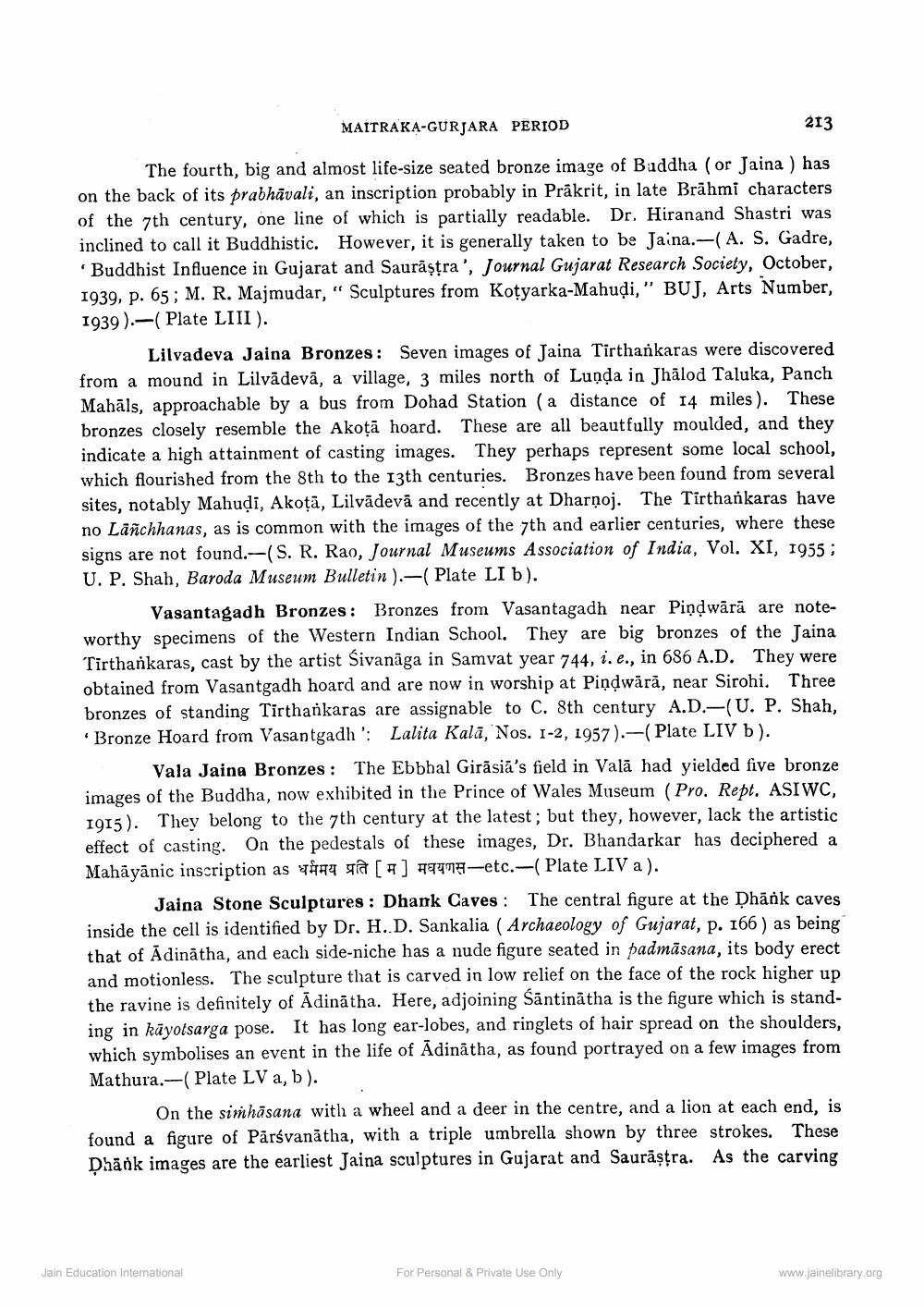________________
MAITRAKA-GURJARA PERIOD
213
The fourth, big and almost life-size seated bronze image of Baddha (or Jaina) has on the back of its prabhavali, an inscription probably in Prakrit, in late Brähmi characters of the 7th century, one line of which is partially readable. Dr. Hiranand Shastri was inclined to call it Buddhistic. However, it is generally taken to be Jaina.-(A. S. Gadre, Buddhist Influence in Gujarat and Saurâstra', Journal Gujarat Research Society, October, 1939, p. 65; M. R. Majmudar," Sculptures from Kotyarka-Mahudi," BUJ, Arts Number, 1939)-( Plate LIII).
Lilvadeva Jaina Bronzes: Seven images of Jaina Tirthankaras were discovered from a mound in Lilvädevä, a village, 3 miles north of Lunda in Jhalod Taluka, Panch Mahāls, approachable by a bus from Dohad Station (a distance of 14 miles). These bronzes closely resemble the Akoță hoard. These are all beautfully moulded, and they indicate a high attainment of casting images. They perhaps represent some local school, which flourished from the 8th to the 13th centuries. Bronzes have been found from several sites, notably Mahudi, Akoță, Lilvädeva and recently at Dharnoj. The Tirthankaras have no Lanchhanas, as is common with the images of the 7th and earlier centuries, where these signs are not found.-(S. R. Rao, Journal Museums Association of India, Vol. XI, 1955; U. P. Shah, Baroda Museum Bulletin ).-( Plate LI b).
Vasantagadh Bronzes: Bronzes from Vasantagadh near Pindwärä are noteworthy specimens of the Western Indian School. They are big bronzes of the Jaina. Tirthankaras, cast by the artist Sivanaga in Samvat year 744, i. e., in 686 A.D. They were obtained from Vasantgadh hoard and are now in worship at Pindwärä, near Sirohi. Three bronzes of standing Tirthankaras are assignable to C. 8th century A.D.-(U. P. Shah, Bronze Hoard from Vasantgadh: Lalita Kala, Nos. 1-2, 1957).-( Plate LIV b).
"
Vala Jaina Bronzes: The Ebbhal Girasia's field in Vala had yielded five bronze images of the Buddha, now exhibited in the Prince of Wales Museum (Pro. Rept. ASIWC, 1915). They belong to the 7th century at the latest; but they, however, lack the artistic effect of casting. On the pedestals of these images, Dr. Bhandarkar has deciphered a Mahayanic inscription as a [] -etc.-( Plate LIV a).
Jaina Stone Sculptares: Dhank Caves: The central figure at the Dhänk caves inside the cell is identified by Dr. H. D. Sankalia (Archaeology of Gujarat, p. 166) as being] that of Adinatha, and each side-niche has a nude figure seated in padmasana, its body erect and motionless. The sculpture that is carved in low relief on the face of the rock higher up the ravine is definitely of Adinatha. Here, adjoining Santinatha is the figure which is standing in kayotsarga pose. It has long ear-lobes, and ringlets of hair spread on the shoulders, which symbolises an event in the life of Adinatha, as found portrayed on a few images from Mathura. (Plate LV a, b).
On the simhasana with a wheel and a deer in the centre, and a lion at each end, is found a figure of Pärśvanatha, with a triple umbrella shown by three strokes. These Dhänk images are the earliest Jaina sculptures in Gujarat and Saurastra. As the carving.
Jain Education International
For Personal & Private Use Only
www.jainelibrary.org




